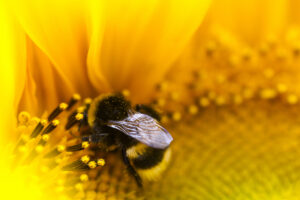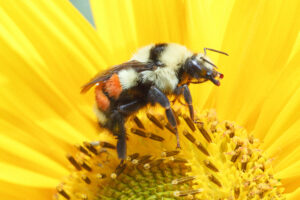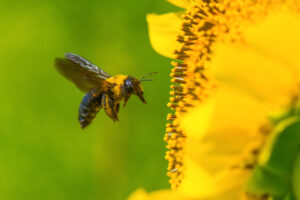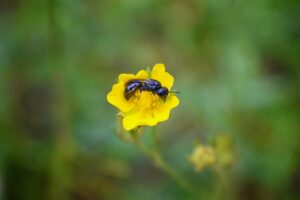A List of Reasons Why We Need Bees!
The recent bee population decline is a big concern for researchers, and it should be for you too. Around the world, bee populations are dwindling before our eyes. In recent years, several domestic and wild bee species have been placed on endangered lists. This is worrisome, as bees are the biggest pollinators and play a vital role in producing crops and sustaining the agriculture industry. In short, this means our food sources are at risk. Think of it this way, all of the vegetables, fruit, and herbs you eat are directly affected by a pollinator. And meat, you ask? Well, animals that provide us with meat are generally herbivores, and therefore require a diet of grasses and vegetation. So even if you eat a diet of mainly meat because you’re not a fan of vegetables, you still need bees. You’re a pescatarian and think fish have nothing to do with the bees that live on land? Fish eat insects that land or lay eggs on the water’s surface, and those bugs that are being eaten have a diet consisting of plants, too. See how that all works? There’s no way the food chain can continue going if bees are removed from the equation — it’s the circle of life, if you will. Protecting bees might not seem like the biggest concern for you specifically, but we want to explain why it is important for everyone to protect our world’s pollinators. We can’t live without bees, and they won’t keep living if we don’t step in and help them. So, here’s everything you need to know about why we need bees and how you can do your part in keeping their population levels high.
Meet the Bee
The word “bee” is an umbrella term for this pollinating insect as there are several species of bees. As of now, there are over 20,000 known species of bees, and the U.S. alone has around 3,500 species. Each type of bee has a specific role and pollinates particular plants, which is why we need bees of all kinds to survive. With just about 500 bee species in the Carolinas, here’s an introduction to some of the most common types!
American Bumble Bee
 The American Bumble Bee is the calmest of the bunch. Known to rarely sting, these bees don’t often swarm. Their bodies are stocky and almost cartoon-ish in appearance. Exoskeletal bristles give them a “fuzzy” texture that allows them to pollinate plants more easily.
The American Bumble Bee is the calmest of the bunch. Known to rarely sting, these bees don’t often swarm. Their bodies are stocky and almost cartoon-ish in appearance. Exoskeletal bristles give them a “fuzzy” texture that allows them to pollinate plants more easily.
Tri-Colored Bumble Bee
 Similar in appearance to its American counterpart, the Tri-Colored Bumble Bee is yellow and black with a bright orange midsection. Tri-Colored Bumble Bees make honey to feed their colony’s larvae into adulthood. Full-developed bees go on to drink nectar.
Similar in appearance to its American counterpart, the Tri-Colored Bumble Bee is yellow and black with a bright orange midsection. Tri-Colored Bumble Bees make honey to feed their colony’s larvae into adulthood. Full-developed bees go on to drink nectar.
Eastern Carpenter Bee
 Large and in charge, the Eastern Carpenter Bee is a massive species. They are mainly black and yellow colored with a subtle metallic tint. Unlike most bee types, the Eastern Carpenter Bee builds nests in wood and other similar materials. These great pollinators visit fruit, vegetable, legume, and decorative flower crops.
Large and in charge, the Eastern Carpenter Bee is a massive species. They are mainly black and yellow colored with a subtle metallic tint. Unlike most bee types, the Eastern Carpenter Bee builds nests in wood and other similar materials. These great pollinators visit fruit, vegetable, legume, and decorative flower crops.
Western Honey Bee
 The Honey Bee is probably the most well-known species on the planet. With several subspecies, the Honey Bee is a broad term describing a class of bees that produce and store honey. Here in the Carolinas, we often see the Western Honey Bee which has (for the most part) been domesticated for crop pollination and honey production. Products made of beeswax, honey, and royal jelly would not exist if it weren’t for the Western Honey Bee. Many cosmetics, personal care items, and home good products are made up of one of these ingredients.
The Honey Bee is probably the most well-known species on the planet. With several subspecies, the Honey Bee is a broad term describing a class of bees that produce and store honey. Here in the Carolinas, we often see the Western Honey Bee which has (for the most part) been domesticated for crop pollination and honey production. Products made of beeswax, honey, and royal jelly would not exist if it weren’t for the Western Honey Bee. Many cosmetics, personal care items, and home good products are made up of one of these ingredients.
Mason Bee
 More efficient at pollinating than the Honey Bee, Mason Bees will pollinate even during wet or cold conditions. In addition, Mason Bees are solitary and do not live in hives with other bees. Rather, they find an empty cavity and will create a nest. Unlike Honey Bees, this species is said to be “hardworking, yet gentle” thanks to their non-aggressive temperament. With so many more bee species calling the Carolinas home, knowing a few of the species you might find buzzing around in your own yard helps bring awareness to this declining insect. Next time you spot a bee, take the time to observe its behavior and appreciate the work it’s doing for you!
More efficient at pollinating than the Honey Bee, Mason Bees will pollinate even during wet or cold conditions. In addition, Mason Bees are solitary and do not live in hives with other bees. Rather, they find an empty cavity and will create a nest. Unlike Honey Bees, this species is said to be “hardworking, yet gentle” thanks to their non-aggressive temperament. With so many more bee species calling the Carolinas home, knowing a few of the species you might find buzzing around in your own yard helps bring awareness to this declining insect. Next time you spot a bee, take the time to observe its behavior and appreciate the work it’s doing for you!
Why We Need Bees
As you know, bees are pollinators, meaning they visit flowers and other plants in search of pollen. In doing so, they catch pollen on their bodies and transfer it to other plants and fertilize them. This pollination process enables all types of plants to bear fruit and seeds. Other pollinators include butterflies, wasps, moths, beetles, and some birds, bats, and lizards; but the bee is by far the most effective because of the number of flowers they visit on a daily basis. In reality, more than 90 percent of the leading global crop types are visited by bees. Farmers rely on the diversity and growth of the bee population to pollinate their produce. Therefore, it’s safe to say that bees literally power the crop industry. Without bees to pollinate, our diets would be dull, poor, and much less nutritious, consisting mainly of rice and corn. In addition, evidence shows that the natural bee pollination process increases the overall quality of crops from the nutritional level to shelf life. By now, we hope you have a clear idea of why we need bees. It’s because our diets and nutritional health rely on what bees do! Bees also contribute to an estimated $15 billion in U.S. crop value. Meaning not only do bees keep humans alive and well, they also fuel our economy.
Why Bees are Becoming Extinct
Bees are currently dying at an economically unsustainable rate of around 30 – 50 percent each year. Unfortunately, scientists say there isn’t one specific reason why bees are disappearing. In fact, there is much debate surrounding the issue. The use of pesticides and climate change seem to be two of the biggest contributing factors, but there are still a lot of unknowns. After WWII, the agricultural use of pesticides became wildly popular. The application of one pesticide in particular, neonicotinoid, has had a detrimental impact not only on the bees, but on the environment in general. Pesticides have been shown to weaken the bee’s immune system and eventually lead to death. While pesticides are believed to harm the overall bee population, little is done to rectify the situation as major corporations continue to use pesticides. Other factors responsible for bee declination include various parasites such as Varroa mites, habitat destruction, and other damaging human practices. To stop wild and domestic bees from becoming extinct, more people must understand why we need bees.
How To Do Your Part
The good news is you, as one person, can do a lot to help preserve your local bee populations! If you’d like to help, here are a few easy things you can do yourself:
Plant a variety of local bee-friendly flowers such as purple coneflower, bee balm, great blue lobelia, and goldenrod.
Be careful not to overspray your yard with chemicals. In part with the Integrated Pest Management philosophy, we also take care not to spray excessively or on any plant that is in bloom.
Buy local honey. Not only is it delicious, but it helps local beekeeper businesses stay afloat.
Buy local, organic food. These foods have been created thanks to our local pollinators.
Learn how to be a beekeeper with sustainable practices. Even small yards can be bee-friendly. Try making your own DIY bee hotel!
Keep a positive attitude when you see a bee, don’t be afraid of them. They will not sting unless aggravated.
Let your government know how important bees are to you. Reach out to your local offices and ask what they’re doing to help your local bee populations grow.
Hopefully, now you’re able to appreciate bees and everything they do for us. We genuinely hope you’ll join us in taking the next steps to save the bees.
Our Part in Protecting the Bees
As an environmentally-focused company, we are always looking for ways to help our bee populations, along with the populations of other beneficial insects. All of our pest control practices are always done with our customers and the environment in mind. To help protect our local bees, we never spray any plants with flowers or any plant about to bloom. Our bee-friendly practices help protect wild bee populations near your home, so they are less likely to come in contact with any type of product meant to get rid of unwanted pests, such as mosquitoes or termites. Just the opposite, we want to make sure we eliminate troublesome pests only!
Protect the Bees with Killingsworth Environmental
The next time you hire a pest control company to protect your home, be sure to do your research because not all pest professionals understand why we need bees! To schedule a bee-friendly pest control service, click the button below. We’ll take care of your pest problems in a responsible way and do our best to protect the bees!